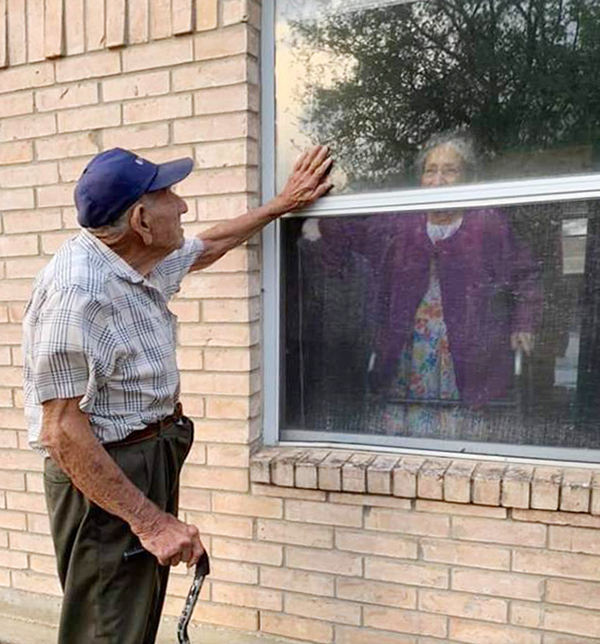
By Kerry Feeney, Associate, Institutional Studio Lead
 As we begin to carefully emerge from self-isolation, we are beginning to realize the impact of the Coronavirus in our lives moving forward. We cannot forget why we implemented these measures in the first place: not to overwhelm the healthcare system, to protects our frontline workers, to shield the immune-compromised and the vulnerable. We have witnessed this virus infiltrating our Senior Living environments with ease and with devastating consequences.
As we begin to carefully emerge from self-isolation, we are beginning to realize the impact of the Coronavirus in our lives moving forward. We cannot forget why we implemented these measures in the first place: not to overwhelm the healthcare system, to protects our frontline workers, to shield the immune-compromised and the vulnerable. We have witnessed this virus infiltrating our Senior Living environments with ease and with devastating consequences.
![]() Many COVID-19 cases in Canada are within Senior Care facilities, exactly where the majority of our vulnerable and immune-compromised citizens reside. The disease has left the elderly scared, alone (in some cases abandoned), and often very sick. Despite the best attempts of care givers, there are some who are dying alone without loved ones by their side. Our older generation has been the hardest hit and they deserve better. Though we do not yet know precisely how or why the virus spreads so rapidly in these populations, as design professionals planning these environments, we need to start thinking about ways to make these facilities safer right now.
Many COVID-19 cases in Canada are within Senior Care facilities, exactly where the majority of our vulnerable and immune-compromised citizens reside. The disease has left the elderly scared, alone (in some cases abandoned), and often very sick. Despite the best attempts of care givers, there are some who are dying alone without loved ones by their side. Our older generation has been the hardest hit and they deserve better. Though we do not yet know precisely how or why the virus spreads so rapidly in these populations, as design professionals planning these environments, we need to start thinking about ways to make these facilities safer right now.![]() People, and the elderly in particular, need community and human connection. They need touch, communication, and care. What does one do when these very things they need so much, could be harmful or worse deadly to them? One of the first thing to consider might be the numbers of residents that make up a community; a planning model that allows for the temporary segregation of living spaces into smaller numbers of people living together could reduce the chance of transmission. Current staffing ratios allow for 16, 32, or 64 residents to be grouped together depending on the level of care and nursing staff available. What if a facility were designed around a staffing model to allow communities to function in groups of 6-12 in an emergency? To make this feasible, most residents would need single rooms with private barrier-free bathrooms and showers (with hands-free fixturing) to allow for proper quarantine and hygienic best practices. Residents would also gain more intimate shared living rooms and dining areas for daily conversation and socialization, much the scale of a family home. To give context, older facilities often have over 32 residents in double occupancy rooms sharing 1-2 toilets with a single communal tub room, dining room, and living space. These can be as crowded and noisy as any college dormitory.
People, and the elderly in particular, need community and human connection. They need touch, communication, and care. What does one do when these very things they need so much, could be harmful or worse deadly to them? One of the first thing to consider might be the numbers of residents that make up a community; a planning model that allows for the temporary segregation of living spaces into smaller numbers of people living together could reduce the chance of transmission. Current staffing ratios allow for 16, 32, or 64 residents to be grouped together depending on the level of care and nursing staff available. What if a facility were designed around a staffing model to allow communities to function in groups of 6-12 in an emergency? To make this feasible, most residents would need single rooms with private barrier-free bathrooms and showers (with hands-free fixturing) to allow for proper quarantine and hygienic best practices. Residents would also gain more intimate shared living rooms and dining areas for daily conversation and socialization, much the scale of a family home. To give context, older facilities often have over 32 residents in double occupancy rooms sharing 1-2 toilets with a single communal tub room, dining room, and living space. These can be as crowded and noisy as any college dormitory. ![]() Another impactful design choice is to provide each of these smaller care units with direct and convenient access to outdoors from both the private rooms (perhaps a ‘Juliette balcony’) and shared spaces (such as terraces or courtyards). Fresh air, sunshine and a change of scenery cannot be underestimated for its value to the human condition witnessed by many of us during this quarantine. Research into biophilia has continued to demonstrate that connection to nature is beneficial to health and healing. All in all, by creating smaller living clusters and the ability to self-isolate in a private room with dignity, the design of the care home begins to limit the potential internal spread of disease.
Another impactful design choice is to provide each of these smaller care units with direct and convenient access to outdoors from both the private rooms (perhaps a ‘Juliette balcony’) and shared spaces (such as terraces or courtyards). Fresh air, sunshine and a change of scenery cannot be underestimated for its value to the human condition witnessed by many of us during this quarantine. Research into biophilia has continued to demonstrate that connection to nature is beneficial to health and healing. All in all, by creating smaller living clusters and the ability to self-isolate in a private room with dignity, the design of the care home begins to limit the potential internal spread of disease. ![]() But what about contagion by staff or visitors? Even the measures above will not be effective if this is not addressed. Entrances will need to be screened more regularly. Can guest and service vestibules be made larger and more secure, with ample accommodation to answer health questionnaires or even provide temperature scanners? Perhaps in an emergency scenario, the second set of doors will not open if a fever is detected. Even mail, packages, food, and other deliveries will necessitate areas where they can be properly decontaminated, at both the front door and the loading docks.
But what about contagion by staff or visitors? Even the measures above will not be effective if this is not addressed. Entrances will need to be screened more regularly. Can guest and service vestibules be made larger and more secure, with ample accommodation to answer health questionnaires or even provide temperature scanners? Perhaps in an emergency scenario, the second set of doors will not open if a fever is detected. Even mail, packages, food, and other deliveries will necessitate areas where they can be properly decontaminated, at both the front door and the loading docks.
Staff are like extended family to many residents and the dedication shown by care and service providers is immeasurable and often heroic. They too must be very fearful to go to work in facilities where they continue to witness the devastating effect of COVID-19. Will they be infected themselves? Will they bring it home and put their families at risk? Proper Personal Protection Equipment (PPE) is a must. More handwash stations will need to be provided. Antimicrobial surfaces will become more prevalent on high-touch surfaces.
But can we do more? Is there a possibility to provide safe and clean, comfortable living quarters for staff during a pandemic? This would let them choose to mitigate their risk to others. Perhaps these staff quarters could be made available at nearby hotels or perhaps in an on-site amenity suite normally reserved for visitors—this would need to be discussed on a case-by-case basis. It is a huge sacrifice to ask, but it might be the answer for some.
My neighbourhood is lucky to have a well-respected Senior Care facility within it. On a cold, brisk walk near the facility, I noticed a family visiting a loved one through the ground floor window of the resident room; they came all bundled up for the cold, with encouraging posters and love. Similar scenarios have been posted on social media. Unconventional? Yes, nevertheless, it was heart-warming to see in person on that cold afternoon. But what about the elderly who do not have ground floor rooms? How are they being encouraged and shown love during this time of isolation?
Immediately, I pictured three possible visitation scenarios for residents and guests.
![]()
The first is a space for non-contact visiting done well, with comfortable seating, discrete, elegantly detailed transparent partitions and built-in audio amplifiers that might be useful for the hearing impaired.
The second idea is simply a welcoming space outdoors that could be physically divided and made safe to allow for visits without having guests enter the facility at all. It would be easily expandable to allow for a number of groups but weather dependent.
The third idea is for video visitation, robust wi-fi networks, software development and training for the ease of use by elderly end users. We have learned that technology is key to keeping all of us safely connected during this current pandemic.
It is my hope that any future planning of seniors’ care will consider some of these as action items to respect and provide dignity to the vulnerable in our society. Advocacy is needed to move these and other ideas going forward to protect the ones we love.
Kerry is an Architect at Number TEN Architectural Group

